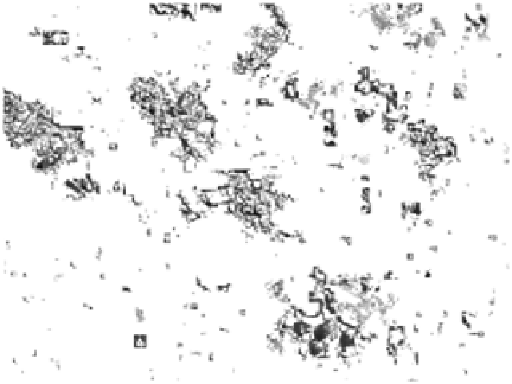Environmental Engineering Reference
In-Depth Information
FIGURE 2.7
Well-developed desert pavements typically also have well-developed desert varnish coatings on rock frag-
ments. This pavement is located in the White Tank Mountains west of Phoenix, Arizona. The scale is 6 in. long.
(Courtesy of W.L. Stefanov.)
exposed rock surface if appropriate environmental conditions and iron and manganese-
bearing dust are available.
Pediments are characterized by an erosional surface that slopes away from a moun-
tain front, usually but not always covered with a thin veneer of sediments or soil. The
pediment surface is typically cut into the same bedrock as the adjacent mountain but
can also truncate both bedrock and alluvium. Recent work based on modeling of sedi-
ment production and transport in the piedmont junction suggest that pediment form
is governed by feedback mechanisms that balance the amount of bedrock erosion with
sediment deposition and transport.
14
While pediments are typically found in semiarid
to arid environments, it is probable that they originally formed under different climatic
and tectonic regimes than exist today; for example, pediment surfaces in granitic rock
in the Mojave Desert have been interpreted as representing a “weathering front” or
exhumed boundary between fresh bedrock and deeply weathered material formed dur-
ing wetter climatic conditions.
15
Dunes
are another landform associated with deserts, caused by the transport and accu-
mulation of predominantly sand-sized particles due to wind (Figure 2.8). Individual dunes
range in size from tens of centimeters to hundreds of meters high and can be from 1 m to
1 km in width. There are many different forms of dunes, but they all are adjusted to the
prevailing wind patterns.* The majority of dunes are located in sand seas or
ergs
; these are
essentially continuous regions of windblown sand that are tens of thousands of square
kilometers in area. Ergs are located in Africa, Arabia, Australia, and Eurasia. Dunefields
contain at least 10 sand dunes but are smaller in size than ergs. Some active dune fields
in the southwestern United States include the Algodones Dune Field in southeastern
California; the White Sands National Monument, New Mexico; and the Kelso Dunes in the
Mojave National Preserve of eastern California. Common sand sources in deserts include
eroding sandstone and granitic bedrock, river sediments, and sediments from dry lake
*
For a more thorough presentation, see Cooke et al.
2


Search WWH ::

Custom Search